Intel DX79SI Review: The Default X79?
by Ian Cutress on November 18, 2011 1:10 AM EST- Posted in
- Motherboards
- Intel
- X79
System Benchmarks
USB Speed
For this benchmark, we run CrystalDiskMark to determine the ideal sequential read and write speeds for the USB port using our 64GB Patriot SuperSpeed USB 3.0 drive. Then we transfer a set size of files from the SSD to the USB drive, and monitor the time taken to transfer. The files transferred are a 1.52 GB set of 2867 files across 320 folders – 95% of these files are small typical website files, and the rest (90% of the size) are the videos used in the Sorenson Squeeze test.
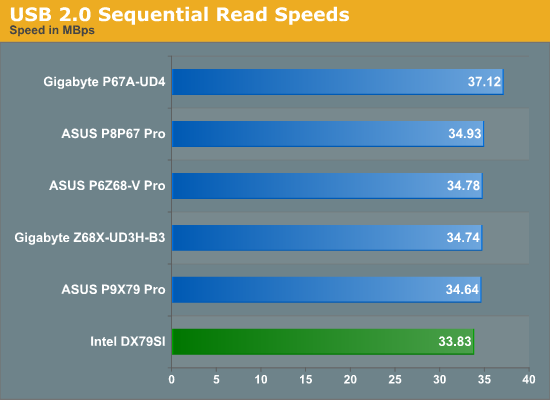

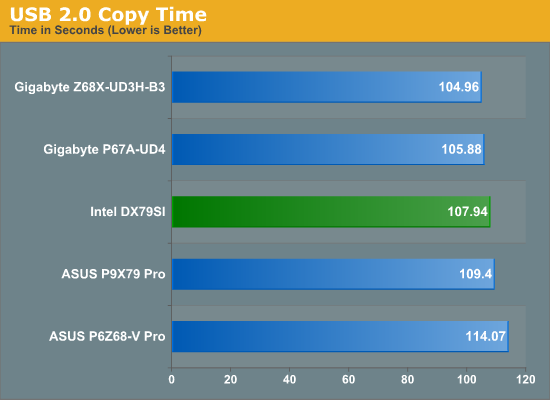
Despite the less than great sequential speeds, the Intel is board still as good as, if not better than, the ASUS P9X79 Pro.
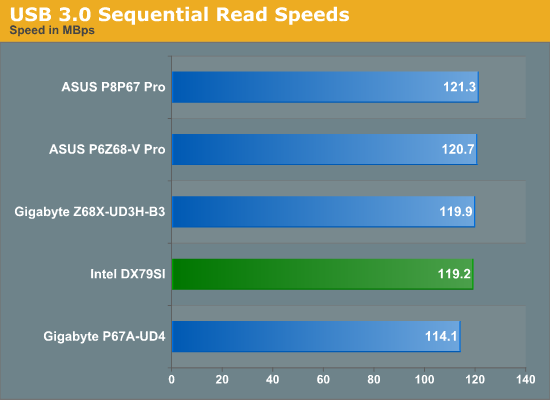
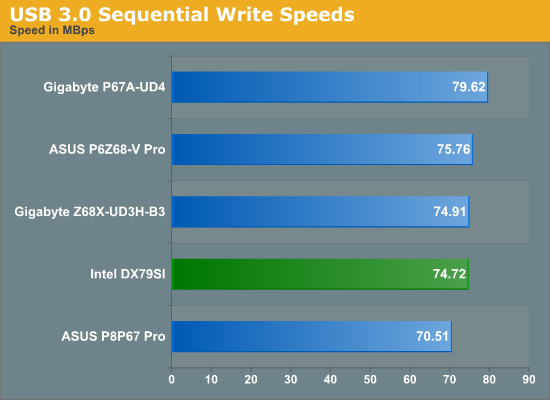
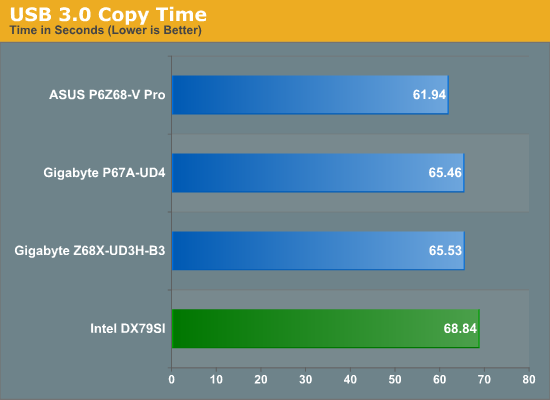
On the other hand, USB 3.0 speeds were relatively disappointing compared to previous chipsets.
SATA Testing
We also use CrystalDiskMark for SATA port testing. The operating system is installed on the Micron RealSSD C300, which is rated at 355 MB/s read and 215 MB/s write, and the sequential test is run at the 5 x 1000 MB level. This test probes the efficiency of the data delivery system between the chipset and the drive, or in the case of additional SATA ports provided by a third party controller, the efficiency between the controller, the chipset and the drive.


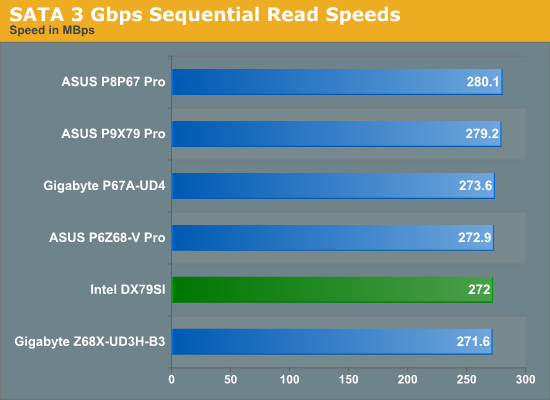
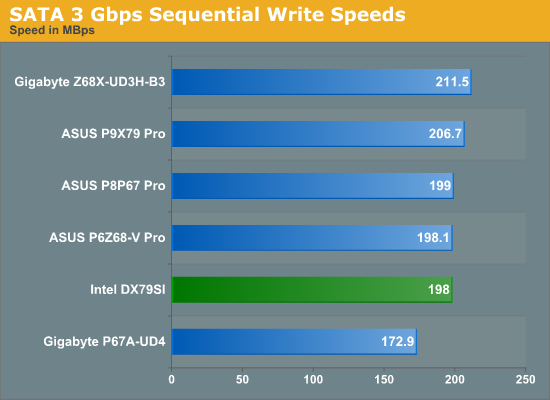
The dichotomy of the SATA results is relatively strange - while in SATA 6 Gbps the DX79SI performs well in sequential testing, the SATA 3 Gbps results are relatively low compared to others.
DPC Latency
Deferred Procedure Call latency is a way in which Windows handles interrupt servicing. In order to wait for a processor to acknowledge the request, the system will queue all interrupt requests by priority. Critical interrupts will be handled as soon as possible, whereas lesser priority requests, such as audio, will be further down the line. So if the audio device requires data, it will have to wait until the request is processed before the buffer is filled. If the device drivers of higher priority components in a system are poorly implemented, this can cause delays in request scheduling and process time, resulting in an empty audio buffer – this leads to characteristic audible pauses, pops and clicks. Having a bigger buffer and correctly implemented system drivers obviously helps in this regard. The DPC latency checker measures how much time is processing DPCs from driver invocation – the lower the value will result in better audio transfer at smaller buffer sizes. Results are measured in microseconds and taken as the peak latency while cycling through a series of short HD videos - under 500 microseconds usually gets the green light, but the lower the better.
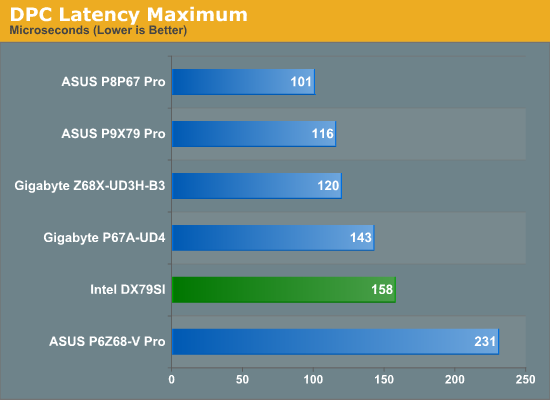
Our previous testing on the ASUS P9X79 showed that on average the DPC Latency was fairly low (~30 microseconds), with the occasional spike in the triple digits. On the other hand, the Intel DX79SI seemed to idle around double that of the ASUS board, with spikes into the 140-150s.










60 Comments
View All Comments
StephaneP - Friday, November 18, 2011 - link
The DPC Latency test is a nice addition.Did you check what peripheral gives this higher DPC ? (Lan, USB3, ...)
ochentay4 - Friday, November 18, 2011 - link
Expensive, not the top of the line, horrbile skull, terrible option in my opinion.tomvh - Friday, November 18, 2011 - link
I am on my fourth Intel motherboard build. I use them because they work. Period !Pperformance ? Probably not up to gamer's standards, I don't play games. But for AV use and general office work, they are fine and fast.
Never had a hiccup with any thing from Intel.
Death666Angel - Friday, November 18, 2011 - link
Why exactly do you use 2 different graphics cards, resulting in 4 different setups? What is testing an old 5850 supposed to accomplish?londiste - Friday, November 18, 2011 - link
and no, skull doesn't make it flashy.i've had a number of intel boards, i've started to take notice of them after 440bx boards. they always tend to lack the cutting edge features even on high-end boards, bioses are always simple and i most cases more limited than other manufacturers but on the other hand these things just work. i have honestly never seen an issue in bios (although judged by readmes their bios updates do fix some issues) and never had to rma any of them (unlike some/most other manufacturers' boards).
specific board does seem a bit overpriced though.
dusteater - Friday, November 18, 2011 - link
Well, I have always Intel branded motherboards in my computer builds. I am in the market for a new computer next year, but am so frustrated at Intel for their USB bungle. I will absolutely not buy a motherboard if it doesn't have all USB 3.0 ports. And I really doubt any OEM's will have any motherboards that meat this requirement either. Just pathetic.tomvh - Friday, November 18, 2011 - link
I agree. There are only a couple of Intel boards with on board USB 3 controllers.I too am hoping that next years Ivy Bridge boards have at least four on the back and a couple headers on the board. I think it may be the cost of USB chips that may be slowing down all board manufacturers.
Doesn't the Ivy Bridge and new chips have native support for USB 3 ?
C300fans - Friday, November 18, 2011 - link
A piece of junk. Are you ready for the 999$ cpu?CharonPDX - Friday, November 18, 2011 - link
Intel always includes SATA cables.ClagMaster - Friday, November 18, 2011 - link
Intel motherboards and BIOS are easy to understand.Intel products are 100% compliant to standards based and offer little room for tweeking because Intel wants their products to be highly reliable.
Most people who buy Intel motherboards do so for their quality and reliability.
Think of how Apple controls their Macs and understand their motivations for doing so.
Then you will understand Intel.